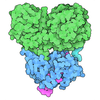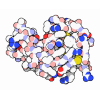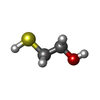[English] 日本語
 Yorodumi
Yorodumi- PDB-2znt: Crystal structure of the ligand-binding core of the human ionotro... -
+ Open data
Open data
- Basic information
Basic information
| Entry | Database: PDB / ID: 2znt | ||||||
|---|---|---|---|---|---|---|---|
| Title | Crystal structure of the ligand-binding core of the human ionotropic glutamate receptor, GluR5, in complex with a novel selective agonist, dysiherbaine | ||||||
 Components Components | Glutamate receptor, ionotropic kainate 1 | ||||||
 Keywords Keywords | MEMBRANE PROTEIN / GluR5 / kainate receptor / ligand-binding core / amino acid / agonist / dysiherbaine / Alternative splicing / Cell junction / Glycoprotein / Ion transport / Ionic channel / Membrane / Phosphoprotein / Polymorphism / Postsynaptic cell membrane / RNA editing / Synapse / Transmembrane / Transport | ||||||
| Function / homology |  Function and homology information Function and homology informationActivation of Na-permeable kainate receptors / kainate selective glutamate receptor complex / Activation of Ca-permeable Kainate Receptor / glutamate receptor signaling pathway / kainate selective glutamate receptor activity / regulation of synaptic transmission, glutamatergic / glutamate-gated receptor activity / glutamate-gated calcium ion channel activity / central nervous system development / transmitter-gated monoatomic ion channel activity involved in regulation of postsynaptic membrane potential ...Activation of Na-permeable kainate receptors / kainate selective glutamate receptor complex / Activation of Ca-permeable Kainate Receptor / glutamate receptor signaling pathway / kainate selective glutamate receptor activity / regulation of synaptic transmission, glutamatergic / glutamate-gated receptor activity / glutamate-gated calcium ion channel activity / central nervous system development / transmitter-gated monoatomic ion channel activity involved in regulation of postsynaptic membrane potential / synaptic transmission, glutamatergic / postsynaptic density membrane / modulation of chemical synaptic transmission / nervous system development / presynaptic membrane / chemical synaptic transmission / intracellular membrane-bounded organelle / plasma membrane Similarity search - Function | ||||||
| Biological species |  Homo sapiens (human) Homo sapiens (human) | ||||||
| Method |  X-RAY DIFFRACTION / X-RAY DIFFRACTION /  SYNCHROTRON / SYNCHROTRON /  MOLECULAR REPLACEMENT / Resolution: 1.6 Å MOLECULAR REPLACEMENT / Resolution: 1.6 Å | ||||||
 Authors Authors | Unno, M. / Sasaki, M. / Ikeda-Saito, M. | ||||||
 Citation Citation |  Journal: J.Mol.Biol. / Year: 2011 Journal: J.Mol.Biol. / Year: 2011Title: Binding and Selectivity of the Marine Toxin Neodysiherbaine A and Its Synthetic Analogues to GluK1 and GluK2 Kainate Receptors. Authors: Unno, M. / Shinohara, M. / Takayama, K. / Tanaka, H. / Teruya, K. / Doh-Ura, K. / Sakai, R. / Sasaki, M. / Ikeda-Saito, M. | ||||||
| History |
|
- Structure visualization
Structure visualization
| Structure viewer | Molecule:  Molmil Molmil Jmol/JSmol Jmol/JSmol |
|---|
- Downloads & links
Downloads & links
- Download
Download
| PDBx/mmCIF format |  2znt.cif.gz 2znt.cif.gz | 125.7 KB | Display |  PDBx/mmCIF format PDBx/mmCIF format |
|---|---|---|---|---|
| PDB format |  pdb2znt.ent.gz pdb2znt.ent.gz | 97 KB | Display |  PDB format PDB format |
| PDBx/mmJSON format |  2znt.json.gz 2znt.json.gz | Tree view |  PDBx/mmJSON format PDBx/mmJSON format | |
| Others |  Other downloads Other downloads |
-Validation report
| Summary document |  2znt_validation.pdf.gz 2znt_validation.pdf.gz | 808.3 KB | Display |  wwPDB validaton report wwPDB validaton report |
|---|---|---|---|---|
| Full document |  2znt_full_validation.pdf.gz 2znt_full_validation.pdf.gz | 810.4 KB | Display | |
| Data in XML |  2znt_validation.xml.gz 2znt_validation.xml.gz | 14.5 KB | Display | |
| Data in CIF |  2znt_validation.cif.gz 2znt_validation.cif.gz | 21.4 KB | Display | |
| Arichive directory |  https://data.pdbj.org/pub/pdb/validation_reports/zn/2znt https://data.pdbj.org/pub/pdb/validation_reports/zn/2znt ftp://data.pdbj.org/pub/pdb/validation_reports/zn/2znt ftp://data.pdbj.org/pub/pdb/validation_reports/zn/2znt | HTTPS FTP |
-Related structure data
| Related structure data | 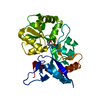 2znsSC 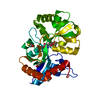 2znuC  3fuzC  3fv1C  3fv2C  3fvgC  3fvkC  3fvnC  3qxmC S: Starting model for refinement C: citing same article ( |
|---|---|
| Similar structure data |
- Links
Links
- Assembly
Assembly
| Deposited unit | 
| ||||||||
|---|---|---|---|---|---|---|---|---|---|
| 1 |
| ||||||||
| Unit cell |
|
- Components
Components
| #1: Protein | Mass: 29093.441 Da / Num. of mol.: 1 Fragment: ligand-binding domain, UNP residues 445-559, UNP residues 682-820 Source method: isolated from a genetically manipulated source Source: (gene. exp.)  Homo sapiens (human) / Gene: GRIK1, GLUR5 / Plasmid: pCold-I DNA / Production host: Homo sapiens (human) / Gene: GRIK1, GLUR5 / Plasmid: pCold-I DNA / Production host:  | ||
|---|---|---|---|
| #2: Chemical | ChemComp-DYH / ( | ||
| #3: Chemical | ChemComp-BME / #4: Water | ChemComp-HOH / | |
-Experimental details
-Experiment
| Experiment | Method:  X-RAY DIFFRACTION / Number of used crystals: 1 X-RAY DIFFRACTION / Number of used crystals: 1 |
|---|
- Sample preparation
Sample preparation
| Crystal | Density Matthews: 3.18 Å3/Da / Density % sol: 61.37 % |
|---|---|
| Crystal grow | Temperature: 279 K / Method: vapor diffusion, hanging drop / pH: 4.8 Details: PEG3350, NaCl, EDTA, pH4.8, VAPOR DIFFUSION, HANGING DROP, temperature 279K |
-Data collection
| Diffraction | Mean temperature: 100 K |
|---|---|
| Diffraction source | Source:  SYNCHROTRON / Site: SYNCHROTRON / Site:  Photon Factory Photon Factory  / Beamline: BL-17A / Wavelength: 1 Å / Beamline: BL-17A / Wavelength: 1 Å |
| Detector | Type: ADSC QUANTUM 270 / Detector: CCD / Date: Oct 11, 2007 |
| Radiation | Protocol: SINGLE WAVELENGTH / Monochromatic (M) / Laue (L): M / Scattering type: x-ray |
| Radiation wavelength | Wavelength: 1 Å / Relative weight: 1 |
| Reflection | Resolution: 1.6→50 Å / Num. obs: 46169 / % possible obs: 96.2 % / Observed criterion σ(F): 0 / Observed criterion σ(I): 0 / Redundancy: 3.7 % / Rsym value: 0.044 / Net I/σ(I): 36.9 |
| Reflection shell | Resolution: 1.6→1.66 Å / Redundancy: 3.1 % / Mean I/σ(I) obs: 2.27 / Num. unique all: 3692 / Rsym value: 0.239 / % possible all: 76.9 |
- Processing
Processing
| Software |
| ||||||||||||||||||||||||||||||||||||||||||||||||||||||||||||||||||||||||||||||||||||||||||
|---|---|---|---|---|---|---|---|---|---|---|---|---|---|---|---|---|---|---|---|---|---|---|---|---|---|---|---|---|---|---|---|---|---|---|---|---|---|---|---|---|---|---|---|---|---|---|---|---|---|---|---|---|---|---|---|---|---|---|---|---|---|---|---|---|---|---|---|---|---|---|---|---|---|---|---|---|---|---|---|---|---|---|---|---|---|---|---|---|---|---|---|
| Refinement | Method to determine structure:  MOLECULAR REPLACEMENT MOLECULAR REPLACEMENTStarting model: PDB ENTRY 2ZNS Resolution: 1.6→30 Å / Cor.coef. Fo:Fc: 0.958 / Cor.coef. Fo:Fc free: 0.945 / SU B: 2.936 / SU ML: 0.053 / Cross valid method: THROUGHOUT / ESU R: 0.087 / ESU R Free: 0.087 / Stereochemistry target values: MAXIMUM LIKELIHOOD / Details: HYDROGENS HAVE BEEN ADDED IN THE RIDING POSITIONS
| ||||||||||||||||||||||||||||||||||||||||||||||||||||||||||||||||||||||||||||||||||||||||||
| Solvent computation | Ion probe radii: 0.8 Å / Shrinkage radii: 0.8 Å / VDW probe radii: 1.2 Å / Solvent model: MASK | ||||||||||||||||||||||||||||||||||||||||||||||||||||||||||||||||||||||||||||||||||||||||||
| Displacement parameters | Biso mean: 27.956 Å2
| ||||||||||||||||||||||||||||||||||||||||||||||||||||||||||||||||||||||||||||||||||||||||||
| Refinement step | Cycle: LAST / Resolution: 1.6→30 Å
| ||||||||||||||||||||||||||||||||||||||||||||||||||||||||||||||||||||||||||||||||||||||||||
| Refine LS restraints |
| ||||||||||||||||||||||||||||||||||||||||||||||||||||||||||||||||||||||||||||||||||||||||||
| LS refinement shell | Resolution: 1.602→1.644 Å / Total num. of bins used: 20
| ||||||||||||||||||||||||||||||||||||||||||||||||||||||||||||||||||||||||||||||||||||||||||
| Refinement TLS params. | Method: refined / Refine-ID: X-RAY DIFFRACTION
| ||||||||||||||||||||||||||||||||||||||||||||||||||||||||||||||||||||||||||||||||||||||||||
| Refinement TLS group |
|
 Movie
Movie Controller
Controller


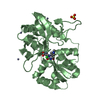
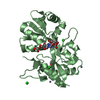




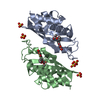



 PDBj
PDBj





